Sustainable Public Health Report: Poverty Analysis in Uganda
VerifiedAdded on 2023/01/12
|11
|3977
|42
Report
AI Summary
This report provides a comprehensive analysis of poverty in Uganda, focusing on its impact on public health and family well-being. It begins with an introduction to the concept of poverty and its prevalence in Uganda, highlighting the country's status as a low-income nation with a significant portion of its population living below the poverty line. The main body delves into the analysis of poverty in Uganda, examining its economic and social dimensions. The report explores the importance of poverty for family health, emphasizing the challenges and barriers faced by families in accessing basic necessities and healthcare. It also discusses short-term and long-term strategies and solutions for poverty reduction, including recommendations for immediate action. Furthermore, the report outlines a partnership plan between India and Uganda to achieve poverty goals, detailing the preparation required for developing this partnership. The report concludes by summarizing the key findings and offering insights into the complex relationship between poverty and public health in Uganda.
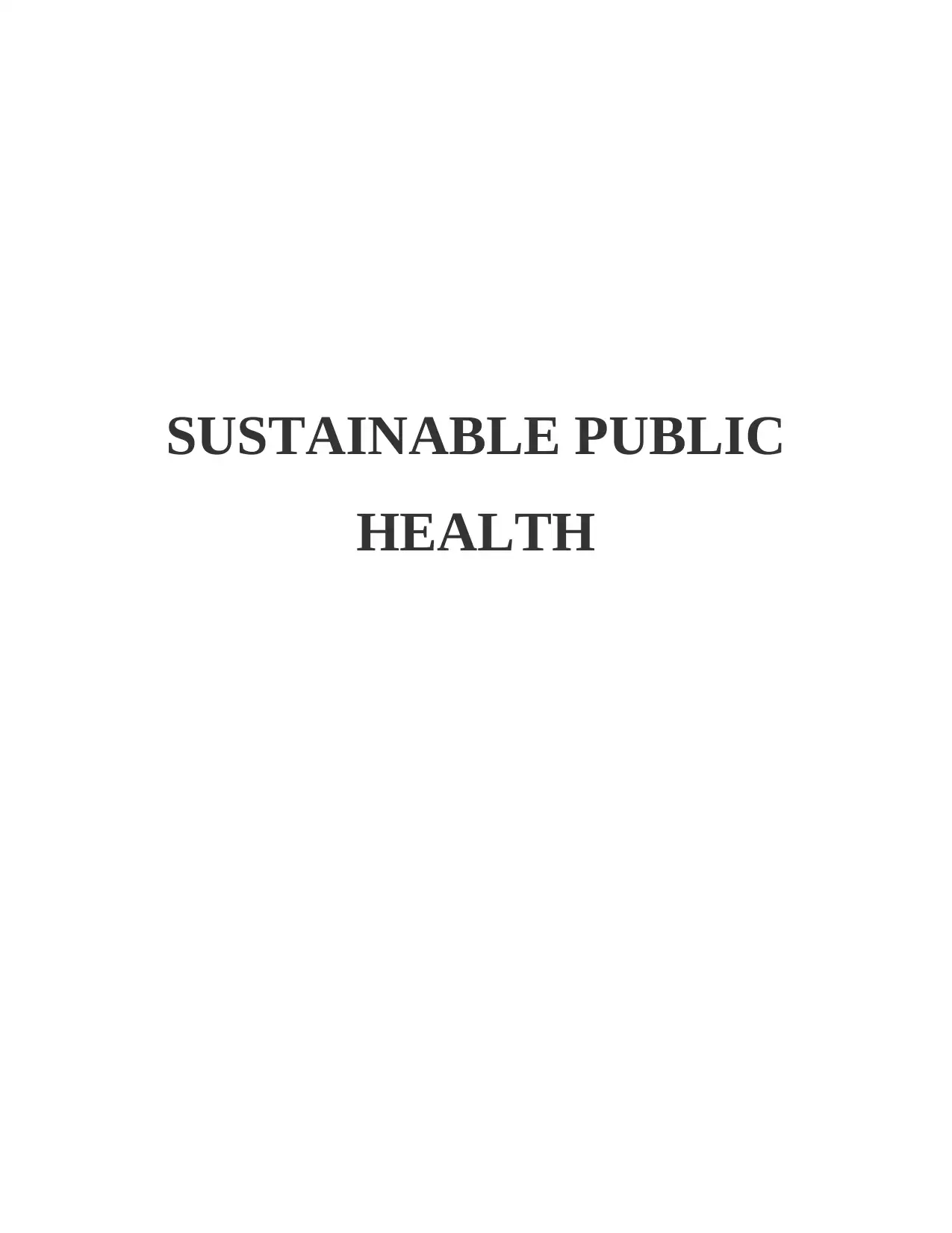
SUSTAINABLE PUBLIC
HEALTH
HEALTH
Paraphrase This Document
Need a fresh take? Get an instant paraphrase of this document with our AI Paraphraser
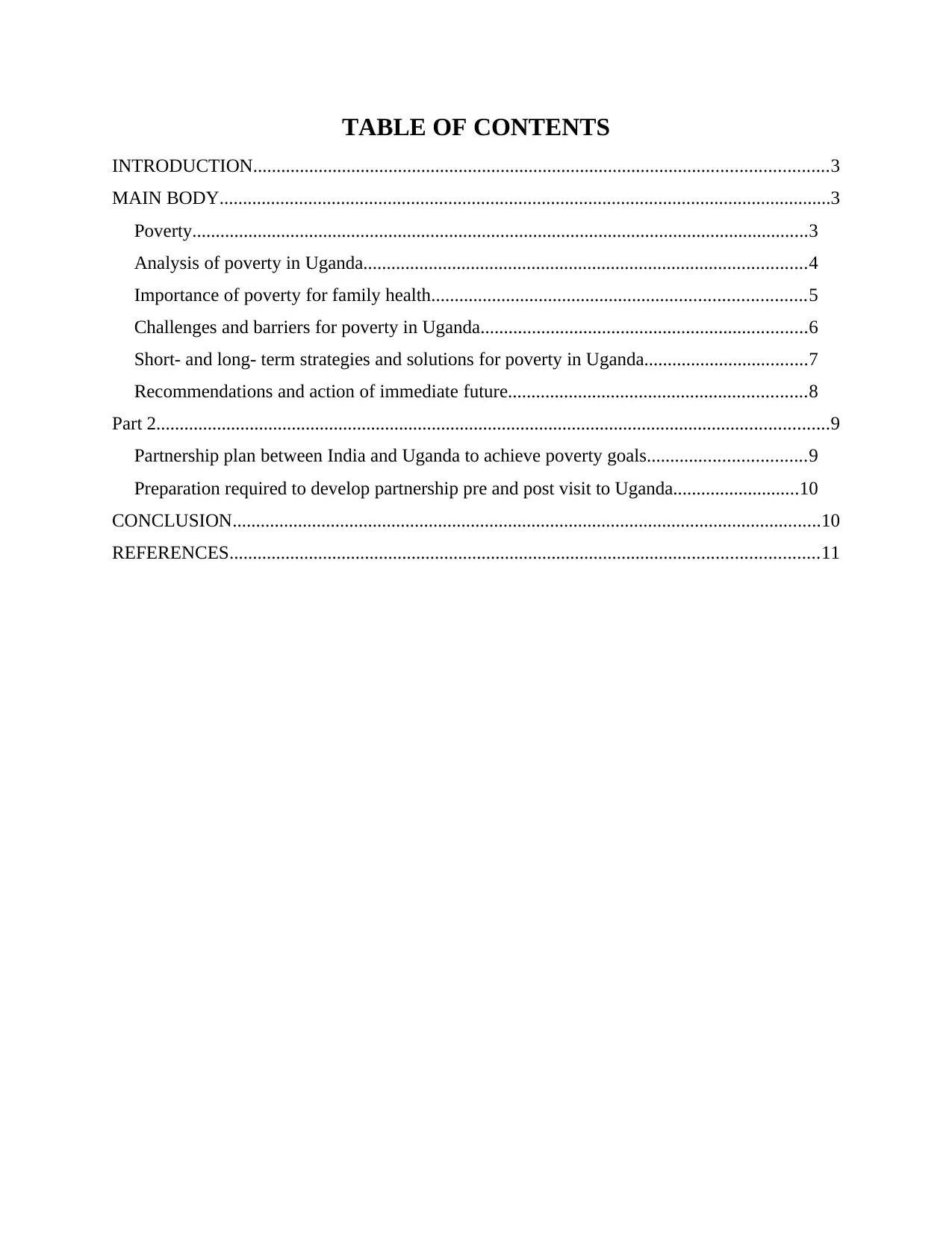
TABLE OF CONTENTS
INTRODUCTION...........................................................................................................................3
MAIN BODY...................................................................................................................................3
Poverty....................................................................................................................................3
Analysis of poverty in Uganda...............................................................................................4
Importance of poverty for family health................................................................................5
Challenges and barriers for poverty in Uganda......................................................................6
Short- and long- term strategies and solutions for poverty in Uganda...................................7
Recommendations and action of immediate future................................................................8
Part 2................................................................................................................................................9
Partnership plan between India and Uganda to achieve poverty goals..................................9
Preparation required to develop partnership pre and post visit to Uganda...........................10
CONCLUSION..............................................................................................................................10
REFERENCES..............................................................................................................................11
INTRODUCTION...........................................................................................................................3
MAIN BODY...................................................................................................................................3
Poverty....................................................................................................................................3
Analysis of poverty in Uganda...............................................................................................4
Importance of poverty for family health................................................................................5
Challenges and barriers for poverty in Uganda......................................................................6
Short- and long- term strategies and solutions for poverty in Uganda...................................7
Recommendations and action of immediate future................................................................8
Part 2................................................................................................................................................9
Partnership plan between India and Uganda to achieve poverty goals..................................9
Preparation required to develop partnership pre and post visit to Uganda...........................10
CONCLUSION..............................................................................................................................10
REFERENCES..............................................................................................................................11
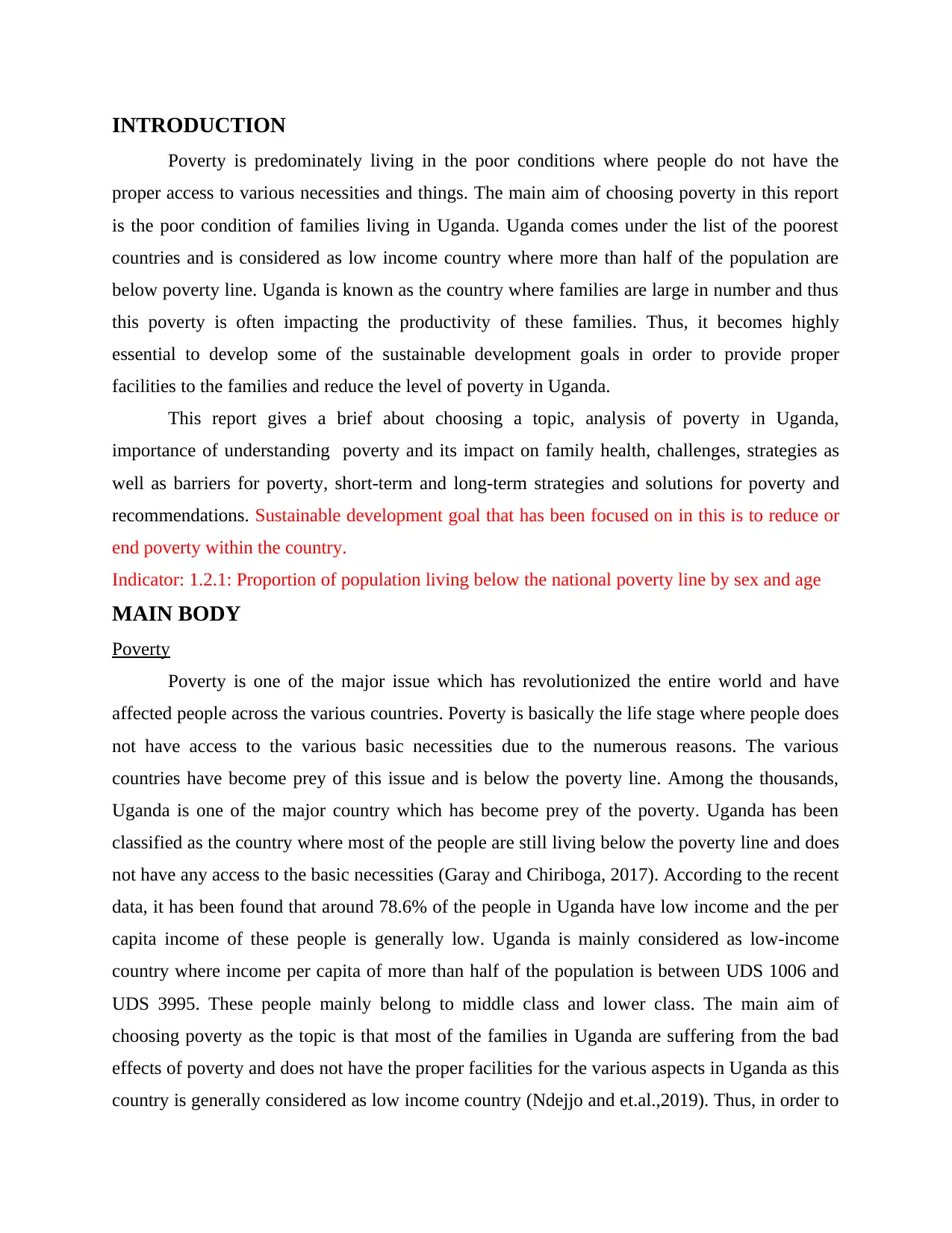
INTRODUCTION
Poverty is predominately living in the poor conditions where people do not have the
proper access to various necessities and things. The main aim of choosing poverty in this report
is the poor condition of families living in Uganda. Uganda comes under the list of the poorest
countries and is considered as low income country where more than half of the population are
below poverty line. Uganda is known as the country where families are large in number and thus
this poverty is often impacting the productivity of these families. Thus, it becomes highly
essential to develop some of the sustainable development goals in order to provide proper
facilities to the families and reduce the level of poverty in Uganda.
This report gives a brief about choosing a topic, analysis of poverty in Uganda,
importance of understanding poverty and its impact on family health, challenges, strategies as
well as barriers for poverty, short-term and long-term strategies and solutions for poverty and
recommendations. Sustainable development goal that has been focused on in this is to reduce or
end poverty within the country.
Indicator: 1.2.1: Proportion of population living below the national poverty line by sex and age
MAIN BODY
Poverty
Poverty is one of the major issue which has revolutionized the entire world and have
affected people across the various countries. Poverty is basically the life stage where people does
not have access to the various basic necessities due to the numerous reasons. The various
countries have become prey of this issue and is below the poverty line. Among the thousands,
Uganda is one of the major country which has become prey of the poverty. Uganda has been
classified as the country where most of the people are still living below the poverty line and does
not have any access to the basic necessities (Garay and Chiriboga, 2017). According to the recent
data, it has been found that around 78.6% of the people in Uganda have low income and the per
capita income of these people is generally low. Uganda is mainly considered as low-income
country where income per capita of more than half of the population is between UDS 1006 and
UDS 3995. These people mainly belong to middle class and lower class. The main aim of
choosing poverty as the topic is that most of the families in Uganda are suffering from the bad
effects of poverty and does not have the proper facilities for the various aspects in Uganda as this
country is generally considered as low income country (Ndejjo and et.al.,2019). Thus, in order to
Poverty is predominately living in the poor conditions where people do not have the
proper access to various necessities and things. The main aim of choosing poverty in this report
is the poor condition of families living in Uganda. Uganda comes under the list of the poorest
countries and is considered as low income country where more than half of the population are
below poverty line. Uganda is known as the country where families are large in number and thus
this poverty is often impacting the productivity of these families. Thus, it becomes highly
essential to develop some of the sustainable development goals in order to provide proper
facilities to the families and reduce the level of poverty in Uganda.
This report gives a brief about choosing a topic, analysis of poverty in Uganda,
importance of understanding poverty and its impact on family health, challenges, strategies as
well as barriers for poverty, short-term and long-term strategies and solutions for poverty and
recommendations. Sustainable development goal that has been focused on in this is to reduce or
end poverty within the country.
Indicator: 1.2.1: Proportion of population living below the national poverty line by sex and age
MAIN BODY
Poverty
Poverty is one of the major issue which has revolutionized the entire world and have
affected people across the various countries. Poverty is basically the life stage where people does
not have access to the various basic necessities due to the numerous reasons. The various
countries have become prey of this issue and is below the poverty line. Among the thousands,
Uganda is one of the major country which has become prey of the poverty. Uganda has been
classified as the country where most of the people are still living below the poverty line and does
not have any access to the basic necessities (Garay and Chiriboga, 2017). According to the recent
data, it has been found that around 78.6% of the people in Uganda have low income and the per
capita income of these people is generally low. Uganda is mainly considered as low-income
country where income per capita of more than half of the population is between UDS 1006 and
UDS 3995. These people mainly belong to middle class and lower class. The main aim of
choosing poverty as the topic is that most of the families in Uganda are suffering from the bad
effects of poverty and does not have the proper facilities for the various aspects in Uganda as this
country is generally considered as low income country (Ndejjo and et.al.,2019). Thus, in order to
⊘ This is a preview!⊘
Do you want full access?
Subscribe today to unlock all pages.

Trusted by 1+ million students worldwide
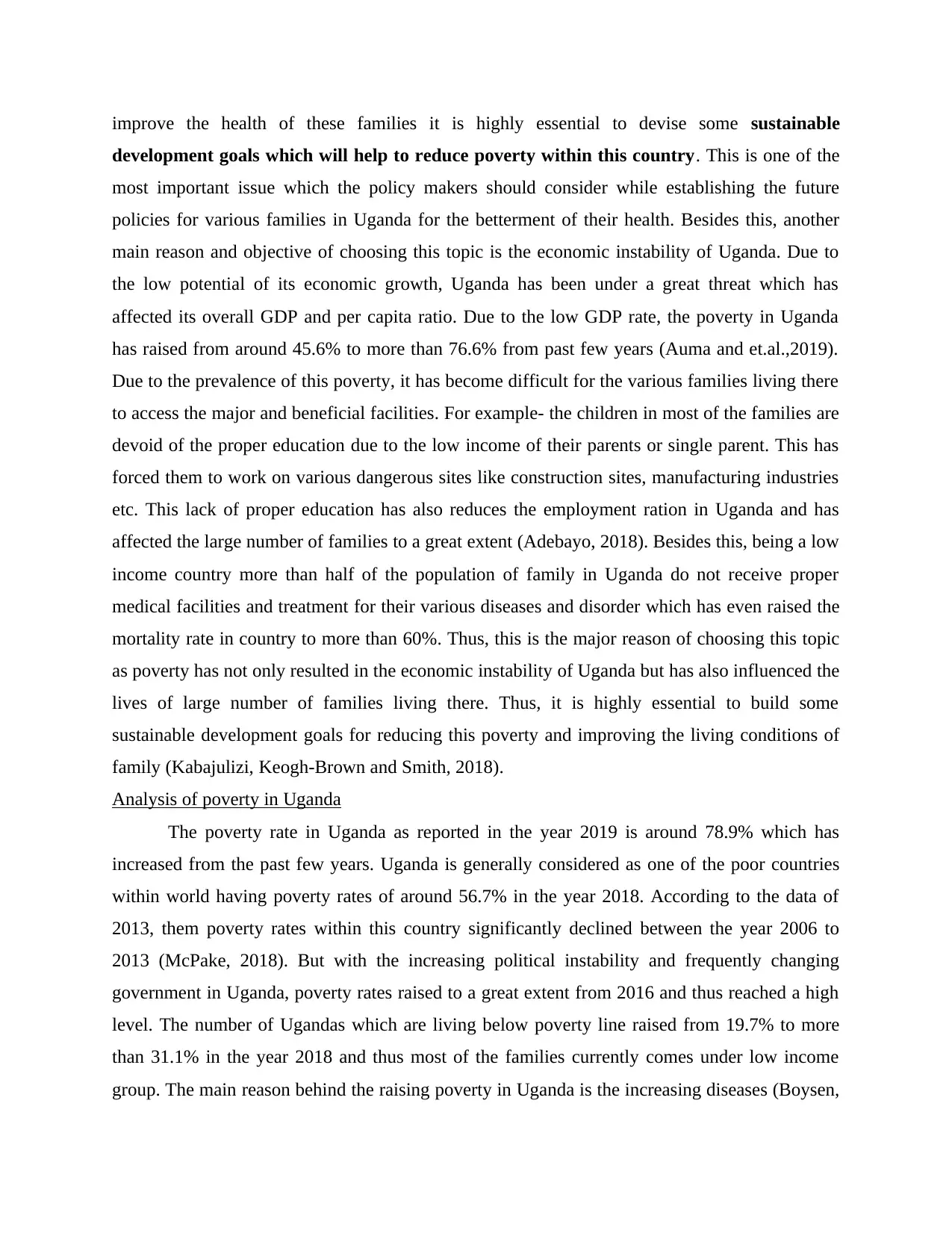
improve the health of these families it is highly essential to devise some sustainable
development goals which will help to reduce poverty within this country. This is one of the
most important issue which the policy makers should consider while establishing the future
policies for various families in Uganda for the betterment of their health. Besides this, another
main reason and objective of choosing this topic is the economic instability of Uganda. Due to
the low potential of its economic growth, Uganda has been under a great threat which has
affected its overall GDP and per capita ratio. Due to the low GDP rate, the poverty in Uganda
has raised from around 45.6% to more than 76.6% from past few years (Auma and et.al.,2019).
Due to the prevalence of this poverty, it has become difficult for the various families living there
to access the major and beneficial facilities. For example- the children in most of the families are
devoid of the proper education due to the low income of their parents or single parent. This has
forced them to work on various dangerous sites like construction sites, manufacturing industries
etc. This lack of proper education has also reduces the employment ration in Uganda and has
affected the large number of families to a great extent (Adebayo, 2018). Besides this, being a low
income country more than half of the population of family in Uganda do not receive proper
medical facilities and treatment for their various diseases and disorder which has even raised the
mortality rate in country to more than 60%. Thus, this is the major reason of choosing this topic
as poverty has not only resulted in the economic instability of Uganda but has also influenced the
lives of large number of families living there. Thus, it is highly essential to build some
sustainable development goals for reducing this poverty and improving the living conditions of
family (Kabajulizi, Keogh-Brown and Smith, 2018).
Analysis of poverty in Uganda
The poverty rate in Uganda as reported in the year 2019 is around 78.9% which has
increased from the past few years. Uganda is generally considered as one of the poor countries
within world having poverty rates of around 56.7% in the year 2018. According to the data of
2013, them poverty rates within this country significantly declined between the year 2006 to
2013 (McPake, 2018). But with the increasing political instability and frequently changing
government in Uganda, poverty rates raised to a great extent from 2016 and thus reached a high
level. The number of Ugandas which are living below poverty line raised from 19.7% to more
than 31.1% in the year 2018 and thus most of the families currently comes under low income
group. The main reason behind the raising poverty in Uganda is the increasing diseases (Boysen,
development goals which will help to reduce poverty within this country. This is one of the
most important issue which the policy makers should consider while establishing the future
policies for various families in Uganda for the betterment of their health. Besides this, another
main reason and objective of choosing this topic is the economic instability of Uganda. Due to
the low potential of its economic growth, Uganda has been under a great threat which has
affected its overall GDP and per capita ratio. Due to the low GDP rate, the poverty in Uganda
has raised from around 45.6% to more than 76.6% from past few years (Auma and et.al.,2019).
Due to the prevalence of this poverty, it has become difficult for the various families living there
to access the major and beneficial facilities. For example- the children in most of the families are
devoid of the proper education due to the low income of their parents or single parent. This has
forced them to work on various dangerous sites like construction sites, manufacturing industries
etc. This lack of proper education has also reduces the employment ration in Uganda and has
affected the large number of families to a great extent (Adebayo, 2018). Besides this, being a low
income country more than half of the population of family in Uganda do not receive proper
medical facilities and treatment for their various diseases and disorder which has even raised the
mortality rate in country to more than 60%. Thus, this is the major reason of choosing this topic
as poverty has not only resulted in the economic instability of Uganda but has also influenced the
lives of large number of families living there. Thus, it is highly essential to build some
sustainable development goals for reducing this poverty and improving the living conditions of
family (Kabajulizi, Keogh-Brown and Smith, 2018).
Analysis of poverty in Uganda
The poverty rate in Uganda as reported in the year 2019 is around 78.9% which has
increased from the past few years. Uganda is generally considered as one of the poor countries
within world having poverty rates of around 56.7% in the year 2018. According to the data of
2013, them poverty rates within this country significantly declined between the year 2006 to
2013 (McPake, 2018). But with the increasing political instability and frequently changing
government in Uganda, poverty rates raised to a great extent from 2016 and thus reached a high
level. The number of Ugandas which are living below poverty line raised from 19.7% to more
than 31.1% in the year 2018 and thus most of the families currently comes under low income
group. The main reason behind the raising poverty in Uganda is the increasing diseases (Boysen,
Paraphrase This Document
Need a fresh take? Get an instant paraphrase of this document with our AI Paraphraser
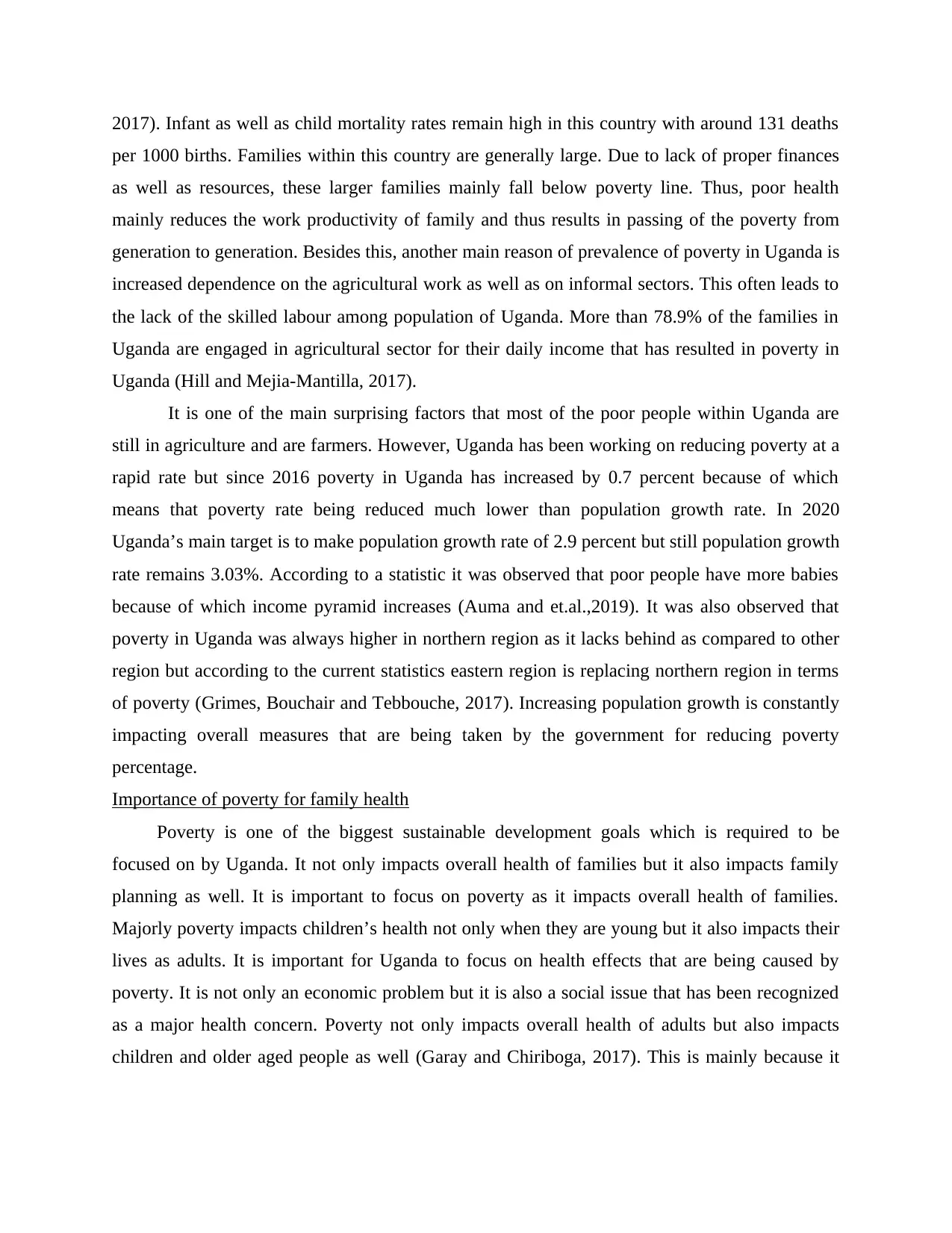
2017). Infant as well as child mortality rates remain high in this country with around 131 deaths
per 1000 births. Families within this country are generally large. Due to lack of proper finances
as well as resources, these larger families mainly fall below poverty line. Thus, poor health
mainly reduces the work productivity of family and thus results in passing of the poverty from
generation to generation. Besides this, another main reason of prevalence of poverty in Uganda is
increased dependence on the agricultural work as well as on informal sectors. This often leads to
the lack of the skilled labour among population of Uganda. More than 78.9% of the families in
Uganda are engaged in agricultural sector for their daily income that has resulted in poverty in
Uganda (Hill and Mejia-Mantilla, 2017).
It is one of the main surprising factors that most of the poor people within Uganda are
still in agriculture and are farmers. However, Uganda has been working on reducing poverty at a
rapid rate but since 2016 poverty in Uganda has increased by 0.7 percent because of which
means that poverty rate being reduced much lower than population growth rate. In 2020
Uganda’s main target is to make population growth rate of 2.9 percent but still population growth
rate remains 3.03%. According to a statistic it was observed that poor people have more babies
because of which income pyramid increases (Auma and et.al.,2019). It was also observed that
poverty in Uganda was always higher in northern region as it lacks behind as compared to other
region but according to the current statistics eastern region is replacing northern region in terms
of poverty (Grimes, Bouchair and Tebbouche, 2017). Increasing population growth is constantly
impacting overall measures that are being taken by the government for reducing poverty
percentage.
Importance of poverty for family health
Poverty is one of the biggest sustainable development goals which is required to be
focused on by Uganda. It not only impacts overall health of families but it also impacts family
planning as well. It is important to focus on poverty as it impacts overall health of families.
Majorly poverty impacts children’s health not only when they are young but it also impacts their
lives as adults. It is important for Uganda to focus on health effects that are being caused by
poverty. It is not only an economic problem but it is also a social issue that has been recognized
as a major health concern. Poverty not only impacts overall health of adults but also impacts
children and older aged people as well (Garay and Chiriboga, 2017). This is mainly because it
per 1000 births. Families within this country are generally large. Due to lack of proper finances
as well as resources, these larger families mainly fall below poverty line. Thus, poor health
mainly reduces the work productivity of family and thus results in passing of the poverty from
generation to generation. Besides this, another main reason of prevalence of poverty in Uganda is
increased dependence on the agricultural work as well as on informal sectors. This often leads to
the lack of the skilled labour among population of Uganda. More than 78.9% of the families in
Uganda are engaged in agricultural sector for their daily income that has resulted in poverty in
Uganda (Hill and Mejia-Mantilla, 2017).
It is one of the main surprising factors that most of the poor people within Uganda are
still in agriculture and are farmers. However, Uganda has been working on reducing poverty at a
rapid rate but since 2016 poverty in Uganda has increased by 0.7 percent because of which
means that poverty rate being reduced much lower than population growth rate. In 2020
Uganda’s main target is to make population growth rate of 2.9 percent but still population growth
rate remains 3.03%. According to a statistic it was observed that poor people have more babies
because of which income pyramid increases (Auma and et.al.,2019). It was also observed that
poverty in Uganda was always higher in northern region as it lacks behind as compared to other
region but according to the current statistics eastern region is replacing northern region in terms
of poverty (Grimes, Bouchair and Tebbouche, 2017). Increasing population growth is constantly
impacting overall measures that are being taken by the government for reducing poverty
percentage.
Importance of poverty for family health
Poverty is one of the biggest sustainable development goals which is required to be
focused on by Uganda. It not only impacts overall health of families but it also impacts family
planning as well. It is important to focus on poverty as it impacts overall health of families.
Majorly poverty impacts children’s health not only when they are young but it also impacts their
lives as adults. It is important for Uganda to focus on health effects that are being caused by
poverty. It is not only an economic problem but it is also a social issue that has been recognized
as a major health concern. Poverty not only impacts overall health of adults but also impacts
children and older aged people as well (Garay and Chiriboga, 2017). This is mainly because it
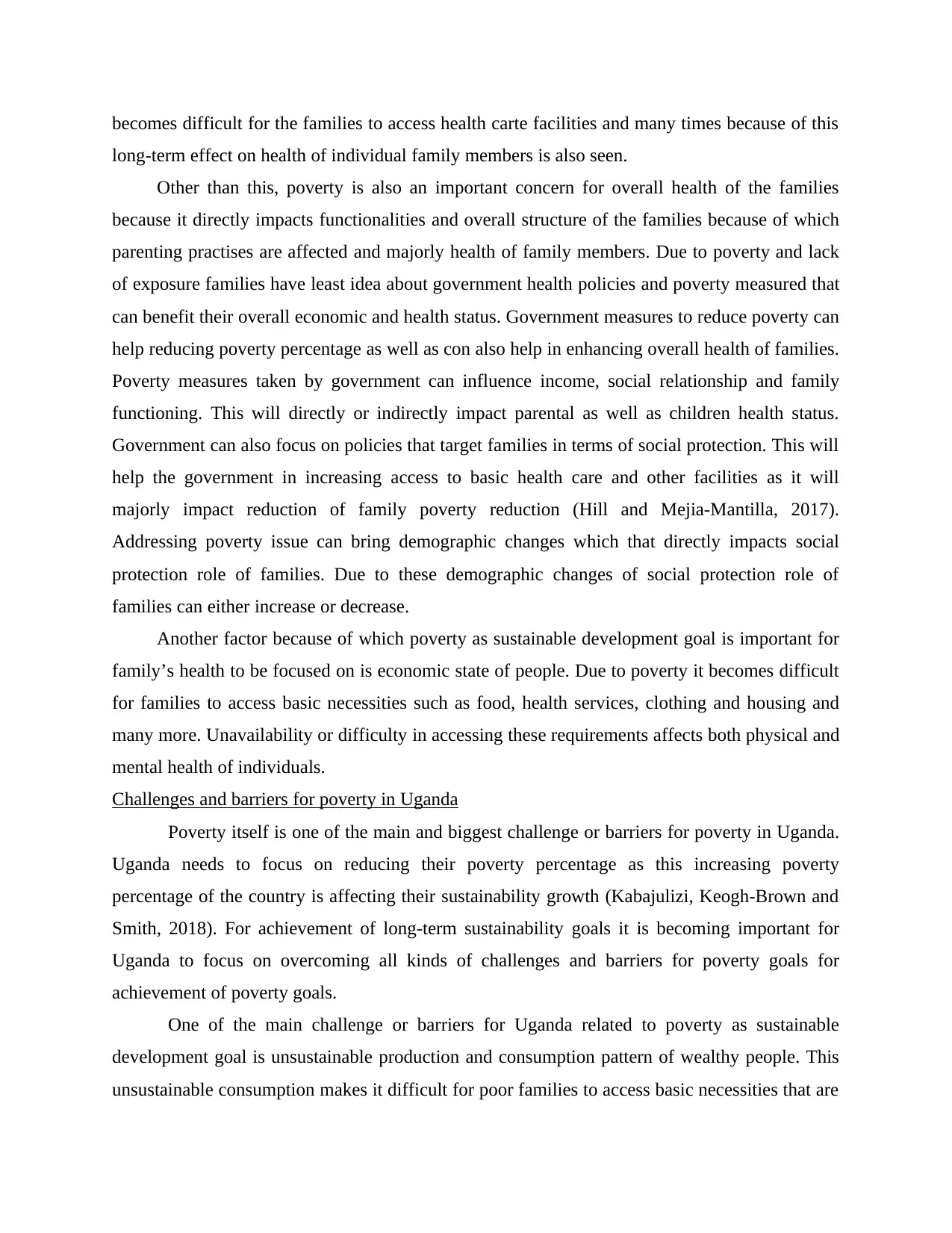
becomes difficult for the families to access health carte facilities and many times because of this
long-term effect on health of individual family members is also seen.
Other than this, poverty is also an important concern for overall health of the families
because it directly impacts functionalities and overall structure of the families because of which
parenting practises are affected and majorly health of family members. Due to poverty and lack
of exposure families have least idea about government health policies and poverty measured that
can benefit their overall economic and health status. Government measures to reduce poverty can
help reducing poverty percentage as well as con also help in enhancing overall health of families.
Poverty measures taken by government can influence income, social relationship and family
functioning. This will directly or indirectly impact parental as well as children health status.
Government can also focus on policies that target families in terms of social protection. This will
help the government in increasing access to basic health care and other facilities as it will
majorly impact reduction of family poverty reduction (Hill and Mejia-Mantilla, 2017).
Addressing poverty issue can bring demographic changes which that directly impacts social
protection role of families. Due to these demographic changes of social protection role of
families can either increase or decrease.
Another factor because of which poverty as sustainable development goal is important for
family’s health to be focused on is economic state of people. Due to poverty it becomes difficult
for families to access basic necessities such as food, health services, clothing and housing and
many more. Unavailability or difficulty in accessing these requirements affects both physical and
mental health of individuals.
Challenges and barriers for poverty in Uganda
Poverty itself is one of the main and biggest challenge or barriers for poverty in Uganda.
Uganda needs to focus on reducing their poverty percentage as this increasing poverty
percentage of the country is affecting their sustainability growth (Kabajulizi, Keogh-Brown and
Smith, 2018). For achievement of long-term sustainability goals it is becoming important for
Uganda to focus on overcoming all kinds of challenges and barriers for poverty goals for
achievement of poverty goals.
One of the main challenge or barriers for Uganda related to poverty as sustainable
development goal is unsustainable production and consumption pattern of wealthy people. This
unsustainable consumption makes it difficult for poor families to access basic necessities that are
long-term effect on health of individual family members is also seen.
Other than this, poverty is also an important concern for overall health of the families
because it directly impacts functionalities and overall structure of the families because of which
parenting practises are affected and majorly health of family members. Due to poverty and lack
of exposure families have least idea about government health policies and poverty measured that
can benefit their overall economic and health status. Government measures to reduce poverty can
help reducing poverty percentage as well as con also help in enhancing overall health of families.
Poverty measures taken by government can influence income, social relationship and family
functioning. This will directly or indirectly impact parental as well as children health status.
Government can also focus on policies that target families in terms of social protection. This will
help the government in increasing access to basic health care and other facilities as it will
majorly impact reduction of family poverty reduction (Hill and Mejia-Mantilla, 2017).
Addressing poverty issue can bring demographic changes which that directly impacts social
protection role of families. Due to these demographic changes of social protection role of
families can either increase or decrease.
Another factor because of which poverty as sustainable development goal is important for
family’s health to be focused on is economic state of people. Due to poverty it becomes difficult
for families to access basic necessities such as food, health services, clothing and housing and
many more. Unavailability or difficulty in accessing these requirements affects both physical and
mental health of individuals.
Challenges and barriers for poverty in Uganda
Poverty itself is one of the main and biggest challenge or barriers for poverty in Uganda.
Uganda needs to focus on reducing their poverty percentage as this increasing poverty
percentage of the country is affecting their sustainability growth (Kabajulizi, Keogh-Brown and
Smith, 2018). For achievement of long-term sustainability goals it is becoming important for
Uganda to focus on overcoming all kinds of challenges and barriers for poverty goals for
achievement of poverty goals.
One of the main challenge or barriers for Uganda related to poverty as sustainable
development goal is unsustainable production and consumption pattern of wealthy people. This
unsustainable consumption makes it difficult for poor families to access basic necessities that are
⊘ This is a preview!⊘
Do you want full access?
Subscribe today to unlock all pages.

Trusted by 1+ million students worldwide
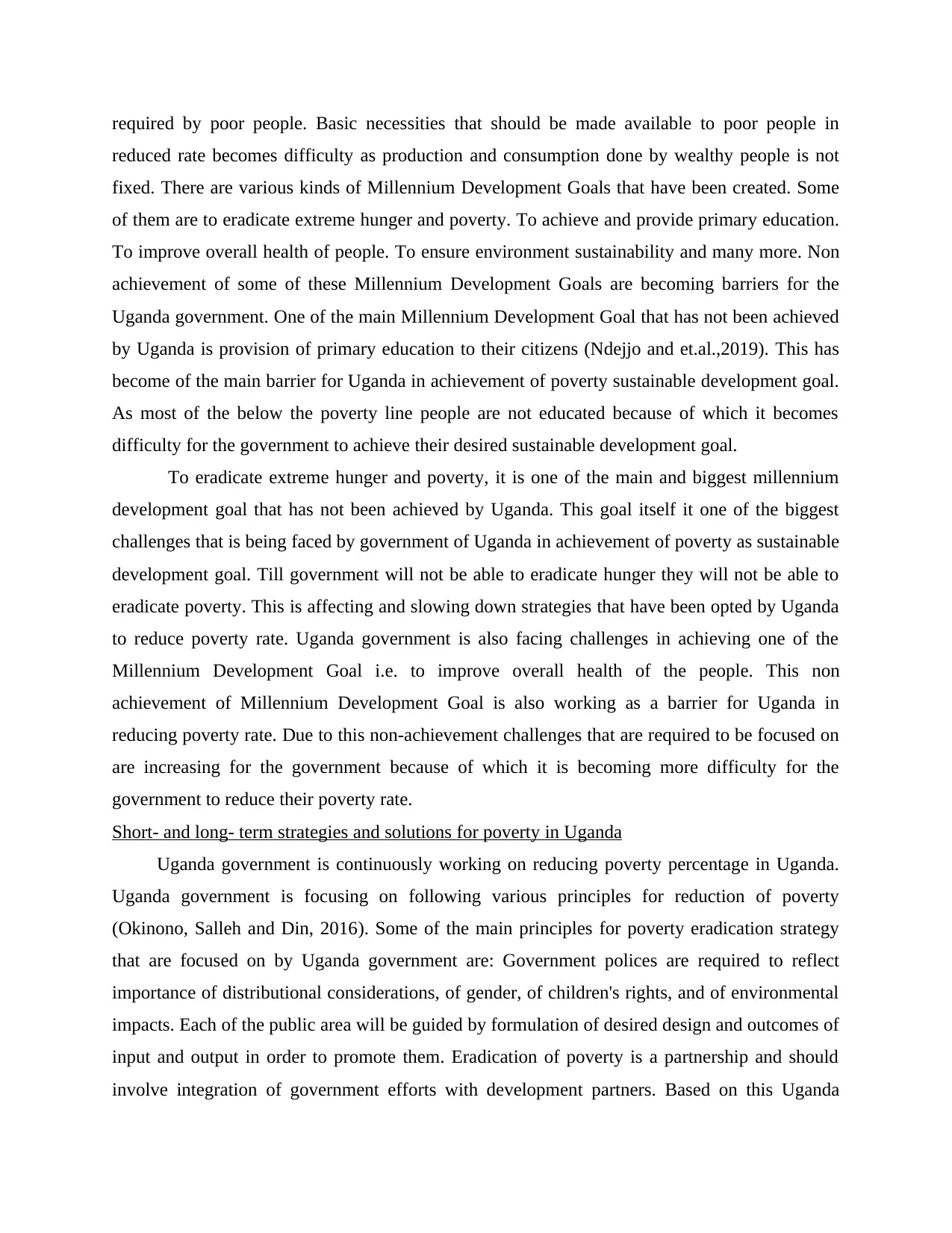
required by poor people. Basic necessities that should be made available to poor people in
reduced rate becomes difficulty as production and consumption done by wealthy people is not
fixed. There are various kinds of Millennium Development Goals that have been created. Some
of them are to eradicate extreme hunger and poverty. To achieve and provide primary education.
To improve overall health of people. To ensure environment sustainability and many more. Non
achievement of some of these Millennium Development Goals are becoming barriers for the
Uganda government. One of the main Millennium Development Goal that has not been achieved
by Uganda is provision of primary education to their citizens (Ndejjo and et.al.,2019). This has
become of the main barrier for Uganda in achievement of poverty sustainable development goal.
As most of the below the poverty line people are not educated because of which it becomes
difficulty for the government to achieve their desired sustainable development goal.
To eradicate extreme hunger and poverty, it is one of the main and biggest millennium
development goal that has not been achieved by Uganda. This goal itself it one of the biggest
challenges that is being faced by government of Uganda in achievement of poverty as sustainable
development goal. Till government will not be able to eradicate hunger they will not be able to
eradicate poverty. This is affecting and slowing down strategies that have been opted by Uganda
to reduce poverty rate. Uganda government is also facing challenges in achieving one of the
Millennium Development Goal i.e. to improve overall health of the people. This non
achievement of Millennium Development Goal is also working as a barrier for Uganda in
reducing poverty rate. Due to this non-achievement challenges that are required to be focused on
are increasing for the government because of which it is becoming more difficulty for the
government to reduce their poverty rate.
Short- and long- term strategies and solutions for poverty in Uganda
Uganda government is continuously working on reducing poverty percentage in Uganda.
Uganda government is focusing on following various principles for reduction of poverty
(Okinono, Salleh and Din, 2016). Some of the main principles for poverty eradication strategy
that are focused on by Uganda government are: Government polices are required to reflect
importance of distributional considerations, of gender, of children's rights, and of environmental
impacts. Each of the public area will be guided by formulation of desired design and outcomes of
input and output in order to promote them. Eradication of poverty is a partnership and should
involve integration of government efforts with development partners. Based on this Uganda
reduced rate becomes difficulty as production and consumption done by wealthy people is not
fixed. There are various kinds of Millennium Development Goals that have been created. Some
of them are to eradicate extreme hunger and poverty. To achieve and provide primary education.
To improve overall health of people. To ensure environment sustainability and many more. Non
achievement of some of these Millennium Development Goals are becoming barriers for the
Uganda government. One of the main Millennium Development Goal that has not been achieved
by Uganda is provision of primary education to their citizens (Ndejjo and et.al.,2019). This has
become of the main barrier for Uganda in achievement of poverty sustainable development goal.
As most of the below the poverty line people are not educated because of which it becomes
difficulty for the government to achieve their desired sustainable development goal.
To eradicate extreme hunger and poverty, it is one of the main and biggest millennium
development goal that has not been achieved by Uganda. This goal itself it one of the biggest
challenges that is being faced by government of Uganda in achievement of poverty as sustainable
development goal. Till government will not be able to eradicate hunger they will not be able to
eradicate poverty. This is affecting and slowing down strategies that have been opted by Uganda
to reduce poverty rate. Uganda government is also facing challenges in achieving one of the
Millennium Development Goal i.e. to improve overall health of the people. This non
achievement of Millennium Development Goal is also working as a barrier for Uganda in
reducing poverty rate. Due to this non-achievement challenges that are required to be focused on
are increasing for the government because of which it is becoming more difficulty for the
government to reduce their poverty rate.
Short- and long- term strategies and solutions for poverty in Uganda
Uganda government is continuously working on reducing poverty percentage in Uganda.
Uganda government is focusing on following various principles for reduction of poverty
(Okinono, Salleh and Din, 2016). Some of the main principles for poverty eradication strategy
that are focused on by Uganda government are: Government polices are required to reflect
importance of distributional considerations, of gender, of children's rights, and of environmental
impacts. Each of the public area will be guided by formulation of desired design and outcomes of
input and output in order to promote them. Eradication of poverty is a partnership and should
involve integration of government efforts with development partners. Based on this Uganda
Paraphrase This Document
Need a fresh take? Get an instant paraphrase of this document with our AI Paraphraser
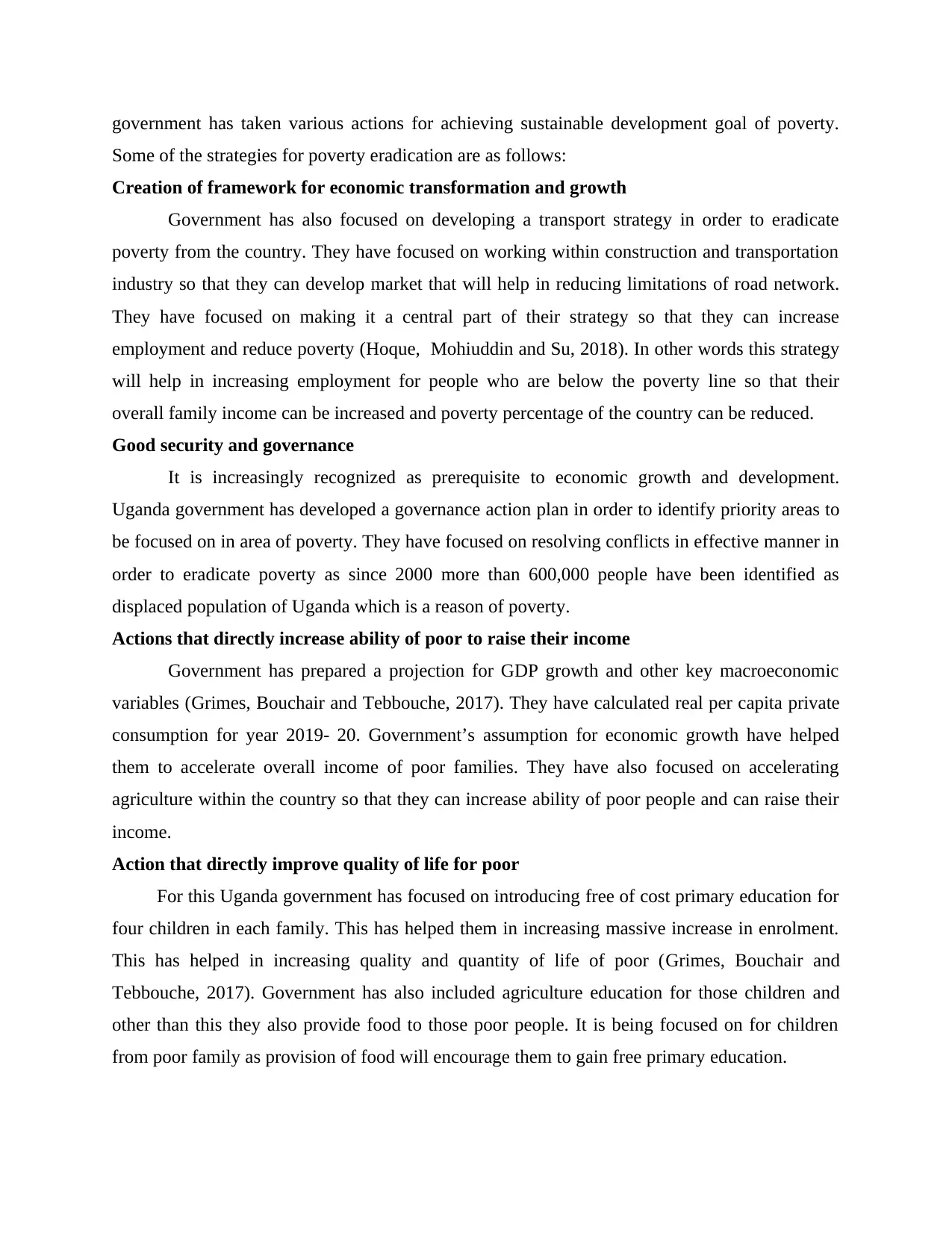
government has taken various actions for achieving sustainable development goal of poverty.
Some of the strategies for poverty eradication are as follows:
Creation of framework for economic transformation and growth
Government has also focused on developing a transport strategy in order to eradicate
poverty from the country. They have focused on working within construction and transportation
industry so that they can develop market that will help in reducing limitations of road network.
They have focused on making it a central part of their strategy so that they can increase
employment and reduce poverty (Hoque, Mohiuddin and Su, 2018). In other words this strategy
will help in increasing employment for people who are below the poverty line so that their
overall family income can be increased and poverty percentage of the country can be reduced.
Good security and governance
It is increasingly recognized as prerequisite to economic growth and development.
Uganda government has developed a governance action plan in order to identify priority areas to
be focused on in area of poverty. They have focused on resolving conflicts in effective manner in
order to eradicate poverty as since 2000 more than 600,000 people have been identified as
displaced population of Uganda which is a reason of poverty.
Actions that directly increase ability of poor to raise their income
Government has prepared a projection for GDP growth and other key macroeconomic
variables (Grimes, Bouchair and Tebbouche, 2017). They have calculated real per capita private
consumption for year 2019- 20. Government’s assumption for economic growth have helped
them to accelerate overall income of poor families. They have also focused on accelerating
agriculture within the country so that they can increase ability of poor people and can raise their
income.
Action that directly improve quality of life for poor
For this Uganda government has focused on introducing free of cost primary education for
four children in each family. This has helped them in increasing massive increase in enrolment.
This has helped in increasing quality and quantity of life of poor (Grimes, Bouchair and
Tebbouche, 2017). Government has also included agriculture education for those children and
other than this they also provide food to those poor people. It is being focused on for children
from poor family as provision of food will encourage them to gain free primary education.
Some of the strategies for poverty eradication are as follows:
Creation of framework for economic transformation and growth
Government has also focused on developing a transport strategy in order to eradicate
poverty from the country. They have focused on working within construction and transportation
industry so that they can develop market that will help in reducing limitations of road network.
They have focused on making it a central part of their strategy so that they can increase
employment and reduce poverty (Hoque, Mohiuddin and Su, 2018). In other words this strategy
will help in increasing employment for people who are below the poverty line so that their
overall family income can be increased and poverty percentage of the country can be reduced.
Good security and governance
It is increasingly recognized as prerequisite to economic growth and development.
Uganda government has developed a governance action plan in order to identify priority areas to
be focused on in area of poverty. They have focused on resolving conflicts in effective manner in
order to eradicate poverty as since 2000 more than 600,000 people have been identified as
displaced population of Uganda which is a reason of poverty.
Actions that directly increase ability of poor to raise their income
Government has prepared a projection for GDP growth and other key macroeconomic
variables (Grimes, Bouchair and Tebbouche, 2017). They have calculated real per capita private
consumption for year 2019- 20. Government’s assumption for economic growth have helped
them to accelerate overall income of poor families. They have also focused on accelerating
agriculture within the country so that they can increase ability of poor people and can raise their
income.
Action that directly improve quality of life for poor
For this Uganda government has focused on introducing free of cost primary education for
four children in each family. This has helped them in increasing massive increase in enrolment.
This has helped in increasing quality and quantity of life of poor (Grimes, Bouchair and
Tebbouche, 2017). Government has also included agriculture education for those children and
other than this they also provide food to those poor people. It is being focused on for children
from poor family as provision of food will encourage them to gain free primary education.
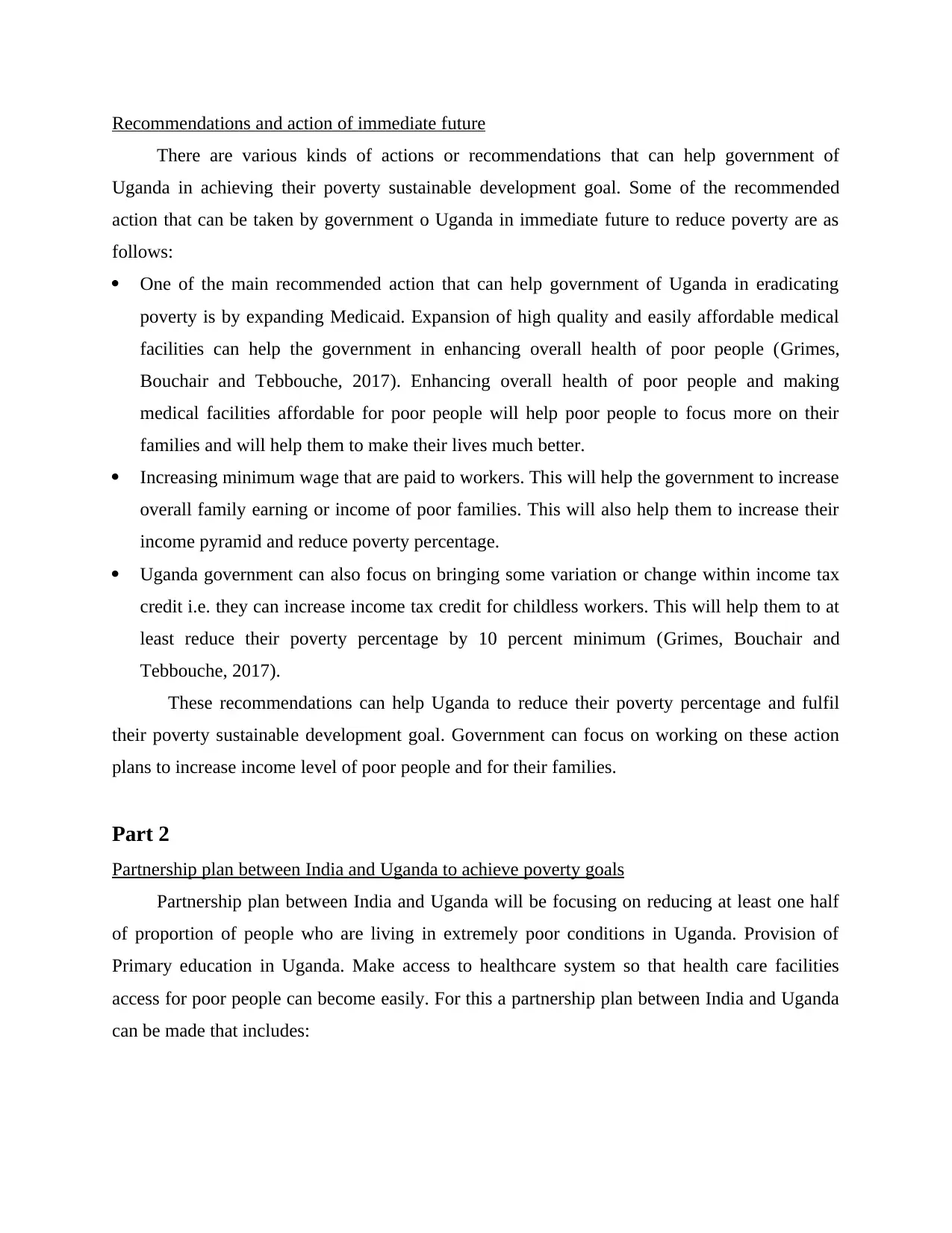
Recommendations and action of immediate future
There are various kinds of actions or recommendations that can help government of
Uganda in achieving their poverty sustainable development goal. Some of the recommended
action that can be taken by government o Uganda in immediate future to reduce poverty are as
follows:
One of the main recommended action that can help government of Uganda in eradicating
poverty is by expanding Medicaid. Expansion of high quality and easily affordable medical
facilities can help the government in enhancing overall health of poor people (Grimes,
Bouchair and Tebbouche, 2017). Enhancing overall health of poor people and making
medical facilities affordable for poor people will help poor people to focus more on their
families and will help them to make their lives much better.
Increasing minimum wage that are paid to workers. This will help the government to increase
overall family earning or income of poor families. This will also help them to increase their
income pyramid and reduce poverty percentage.
Uganda government can also focus on bringing some variation or change within income tax
credit i.e. they can increase income tax credit for childless workers. This will help them to at
least reduce their poverty percentage by 10 percent minimum (Grimes, Bouchair and
Tebbouche, 2017).
These recommendations can help Uganda to reduce their poverty percentage and fulfil
their poverty sustainable development goal. Government can focus on working on these action
plans to increase income level of poor people and for their families.
Part 2
Partnership plan between India and Uganda to achieve poverty goals
Partnership plan between India and Uganda will be focusing on reducing at least one half
of proportion of people who are living in extremely poor conditions in Uganda. Provision of
Primary education in Uganda. Make access to healthcare system so that health care facilities
access for poor people can become easily. For this a partnership plan between India and Uganda
can be made that includes:
There are various kinds of actions or recommendations that can help government of
Uganda in achieving their poverty sustainable development goal. Some of the recommended
action that can be taken by government o Uganda in immediate future to reduce poverty are as
follows:
One of the main recommended action that can help government of Uganda in eradicating
poverty is by expanding Medicaid. Expansion of high quality and easily affordable medical
facilities can help the government in enhancing overall health of poor people (Grimes,
Bouchair and Tebbouche, 2017). Enhancing overall health of poor people and making
medical facilities affordable for poor people will help poor people to focus more on their
families and will help them to make their lives much better.
Increasing minimum wage that are paid to workers. This will help the government to increase
overall family earning or income of poor families. This will also help them to increase their
income pyramid and reduce poverty percentage.
Uganda government can also focus on bringing some variation or change within income tax
credit i.e. they can increase income tax credit for childless workers. This will help them to at
least reduce their poverty percentage by 10 percent minimum (Grimes, Bouchair and
Tebbouche, 2017).
These recommendations can help Uganda to reduce their poverty percentage and fulfil
their poverty sustainable development goal. Government can focus on working on these action
plans to increase income level of poor people and for their families.
Part 2
Partnership plan between India and Uganda to achieve poverty goals
Partnership plan between India and Uganda will be focusing on reducing at least one half
of proportion of people who are living in extremely poor conditions in Uganda. Provision of
Primary education in Uganda. Make access to healthcare system so that health care facilities
access for poor people can become easily. For this a partnership plan between India and Uganda
can be made that includes:
⊘ This is a preview!⊘
Do you want full access?
Subscribe today to unlock all pages.

Trusted by 1+ million students worldwide
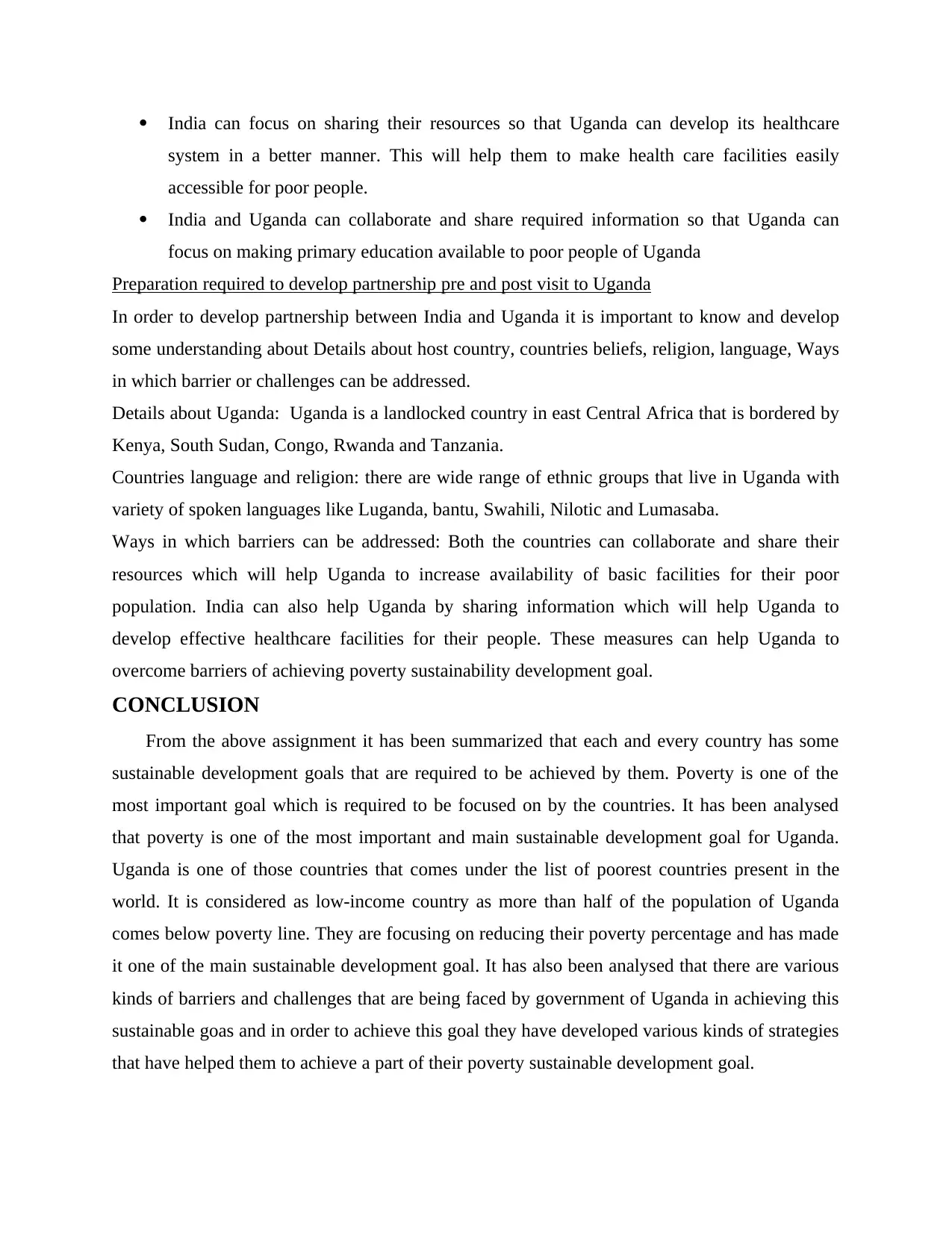
India can focus on sharing their resources so that Uganda can develop its healthcare
system in a better manner. This will help them to make health care facilities easily
accessible for poor people.
India and Uganda can collaborate and share required information so that Uganda can
focus on making primary education available to poor people of Uganda
Preparation required to develop partnership pre and post visit to Uganda
In order to develop partnership between India and Uganda it is important to know and develop
some understanding about Details about host country, countries beliefs, religion, language, Ways
in which barrier or challenges can be addressed.
Details about Uganda: Uganda is a landlocked country in east Central Africa that is bordered by
Kenya, South Sudan, Congo, Rwanda and Tanzania.
Countries language and religion: there are wide range of ethnic groups that live in Uganda with
variety of spoken languages like Luganda, bantu, Swahili, Nilotic and Lumasaba.
Ways in which barriers can be addressed: Both the countries can collaborate and share their
resources which will help Uganda to increase availability of basic facilities for their poor
population. India can also help Uganda by sharing information which will help Uganda to
develop effective healthcare facilities for their people. These measures can help Uganda to
overcome barriers of achieving poverty sustainability development goal.
CONCLUSION
From the above assignment it has been summarized that each and every country has some
sustainable development goals that are required to be achieved by them. Poverty is one of the
most important goal which is required to be focused on by the countries. It has been analysed
that poverty is one of the most important and main sustainable development goal for Uganda.
Uganda is one of those countries that comes under the list of poorest countries present in the
world. It is considered as low-income country as more than half of the population of Uganda
comes below poverty line. They are focusing on reducing their poverty percentage and has made
it one of the main sustainable development goal. It has also been analysed that there are various
kinds of barriers and challenges that are being faced by government of Uganda in achieving this
sustainable goas and in order to achieve this goal they have developed various kinds of strategies
that have helped them to achieve a part of their poverty sustainable development goal.
system in a better manner. This will help them to make health care facilities easily
accessible for poor people.
India and Uganda can collaborate and share required information so that Uganda can
focus on making primary education available to poor people of Uganda
Preparation required to develop partnership pre and post visit to Uganda
In order to develop partnership between India and Uganda it is important to know and develop
some understanding about Details about host country, countries beliefs, religion, language, Ways
in which barrier or challenges can be addressed.
Details about Uganda: Uganda is a landlocked country in east Central Africa that is bordered by
Kenya, South Sudan, Congo, Rwanda and Tanzania.
Countries language and religion: there are wide range of ethnic groups that live in Uganda with
variety of spoken languages like Luganda, bantu, Swahili, Nilotic and Lumasaba.
Ways in which barriers can be addressed: Both the countries can collaborate and share their
resources which will help Uganda to increase availability of basic facilities for their poor
population. India can also help Uganda by sharing information which will help Uganda to
develop effective healthcare facilities for their people. These measures can help Uganda to
overcome barriers of achieving poverty sustainability development goal.
CONCLUSION
From the above assignment it has been summarized that each and every country has some
sustainable development goals that are required to be achieved by them. Poverty is one of the
most important goal which is required to be focused on by the countries. It has been analysed
that poverty is one of the most important and main sustainable development goal for Uganda.
Uganda is one of those countries that comes under the list of poorest countries present in the
world. It is considered as low-income country as more than half of the population of Uganda
comes below poverty line. They are focusing on reducing their poverty percentage and has made
it one of the main sustainable development goal. It has also been analysed that there are various
kinds of barriers and challenges that are being faced by government of Uganda in achieving this
sustainable goas and in order to achieve this goal they have developed various kinds of strategies
that have helped them to achieve a part of their poverty sustainable development goal.
Paraphrase This Document
Need a fresh take? Get an instant paraphrase of this document with our AI Paraphraser
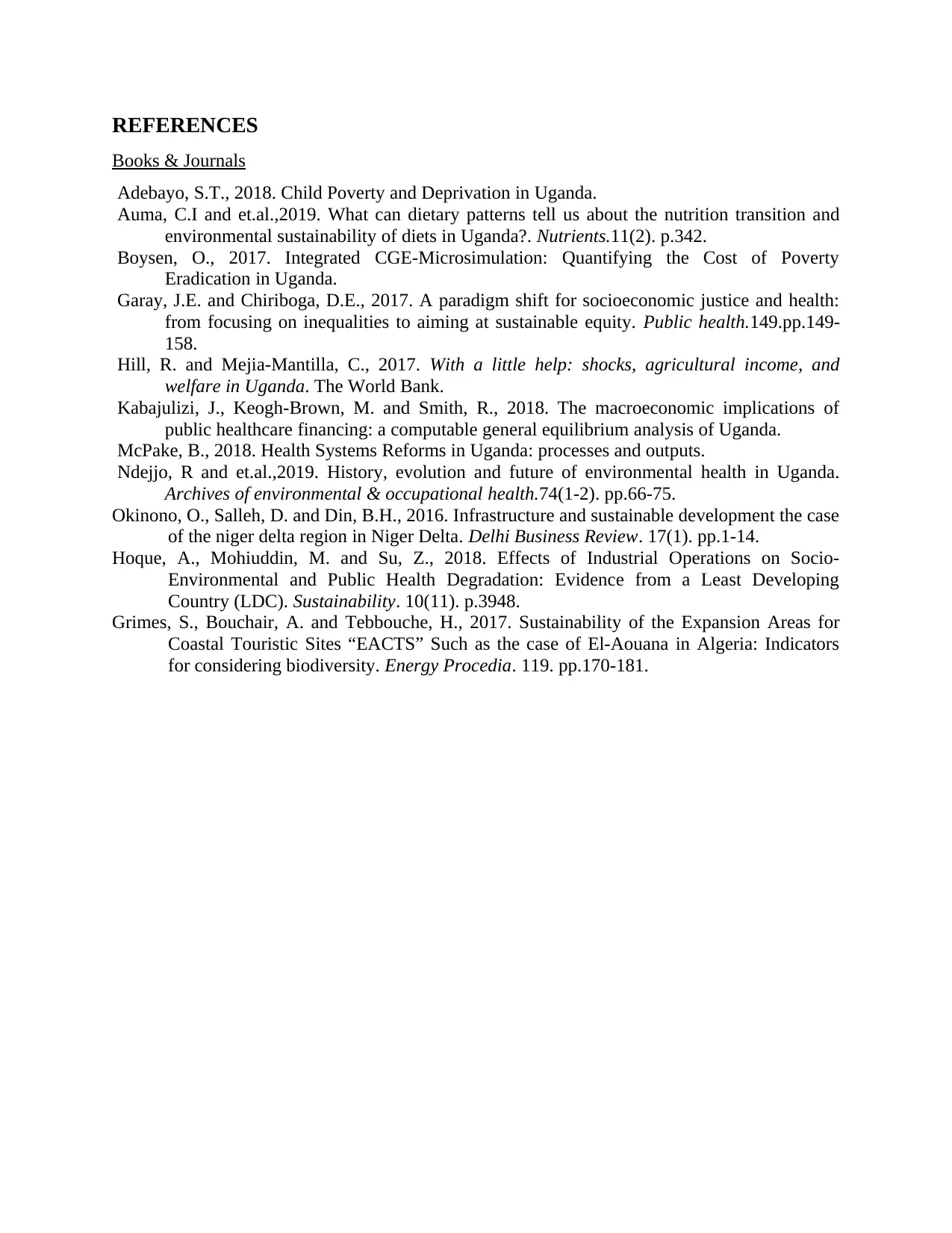
REFERENCES
Books & Journals
Adebayo, S.T., 2018. Child Poverty and Deprivation in Uganda.
Auma, C.I and et.al.,2019. What can dietary patterns tell us about the nutrition transition and
environmental sustainability of diets in Uganda?. Nutrients.11(2). p.342.
Boysen, O., 2017. Integrated CGE-Microsimulation: Quantifying the Cost of Poverty
Eradication in Uganda.
Garay, J.E. and Chiriboga, D.E., 2017. A paradigm shift for socioeconomic justice and health:
from focusing on inequalities to aiming at sustainable equity. Public health.149.pp.149-
158.
Hill, R. and Mejia-Mantilla, C., 2017. With a little help: shocks, agricultural income, and
welfare in Uganda. The World Bank.
Kabajulizi, J., Keogh-Brown, M. and Smith, R., 2018. The macroeconomic implications of
public healthcare financing: a computable general equilibrium analysis of Uganda.
McPake, B., 2018. Health Systems Reforms in Uganda: processes and outputs.
Ndejjo, R and et.al.,2019. History, evolution and future of environmental health in Uganda.
Archives of environmental & occupational health.74(1-2). pp.66-75.
Okinono, O., Salleh, D. and Din, B.H., 2016. Infrastructure and sustainable development the case
of the niger delta region in Niger Delta. Delhi Business Review. 17(1). pp.1-14.
Hoque, A., Mohiuddin, M. and Su, Z., 2018. Effects of Industrial Operations on Socio-
Environmental and Public Health Degradation: Evidence from a Least Developing
Country (LDC). Sustainability. 10(11). p.3948.
Grimes, S., Bouchair, A. and Tebbouche, H., 2017. Sustainability of the Expansion Areas for
Coastal Touristic Sites “EACTS” Such as the case of El-Aouana in Algeria: Indicators
for considering biodiversity. Energy Procedia. 119. pp.170-181.
Books & Journals
Adebayo, S.T., 2018. Child Poverty and Deprivation in Uganda.
Auma, C.I and et.al.,2019. What can dietary patterns tell us about the nutrition transition and
environmental sustainability of diets in Uganda?. Nutrients.11(2). p.342.
Boysen, O., 2017. Integrated CGE-Microsimulation: Quantifying the Cost of Poverty
Eradication in Uganda.
Garay, J.E. and Chiriboga, D.E., 2017. A paradigm shift for socioeconomic justice and health:
from focusing on inequalities to aiming at sustainable equity. Public health.149.pp.149-
158.
Hill, R. and Mejia-Mantilla, C., 2017. With a little help: shocks, agricultural income, and
welfare in Uganda. The World Bank.
Kabajulizi, J., Keogh-Brown, M. and Smith, R., 2018. The macroeconomic implications of
public healthcare financing: a computable general equilibrium analysis of Uganda.
McPake, B., 2018. Health Systems Reforms in Uganda: processes and outputs.
Ndejjo, R and et.al.,2019. History, evolution and future of environmental health in Uganda.
Archives of environmental & occupational health.74(1-2). pp.66-75.
Okinono, O., Salleh, D. and Din, B.H., 2016. Infrastructure and sustainable development the case
of the niger delta region in Niger Delta. Delhi Business Review. 17(1). pp.1-14.
Hoque, A., Mohiuddin, M. and Su, Z., 2018. Effects of Industrial Operations on Socio-
Environmental and Public Health Degradation: Evidence from a Least Developing
Country (LDC). Sustainability. 10(11). p.3948.
Grimes, S., Bouchair, A. and Tebbouche, H., 2017. Sustainability of the Expansion Areas for
Coastal Touristic Sites “EACTS” Such as the case of El-Aouana in Algeria: Indicators
for considering biodiversity. Energy Procedia. 119. pp.170-181.
1 out of 11
Related Documents
Your All-in-One AI-Powered Toolkit for Academic Success.
+13062052269
info@desklib.com
Available 24*7 on WhatsApp / Email
![[object Object]](/_next/static/media/star-bottom.7253800d.svg)
Unlock your academic potential
Copyright © 2020–2025 A2Z Services. All Rights Reserved. Developed and managed by ZUCOL.





